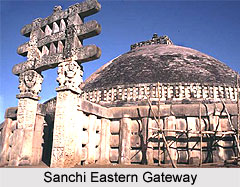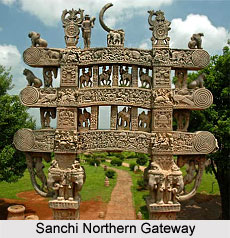 The gateways of Sanchi date back to the first century BC; however, the earliest to be built was the one on the south, which is believed to have been the principal entrance. This is proved also by the presence of Ashokan pillar and the landing with a stairway on that side. The remaining gateways - North, East and West - were subsequently constructed. The south pillar of the West Gateway and the middle architrave of the South Gateway were gifts by one Balamitra; while Nagapiya, a native of Kurara, was the donor of the south pillar of the East Gateway and the north pillar of the West Gateway.
The gateways of Sanchi date back to the first century BC; however, the earliest to be built was the one on the south, which is believed to have been the principal entrance. This is proved also by the presence of Ashokan pillar and the landing with a stairway on that side. The remaining gateways - North, East and West - were subsequently constructed. The south pillar of the West Gateway and the middle architrave of the South Gateway were gifts by one Balamitra; while Nagapiya, a native of Kurara, was the donor of the south pillar of the East Gateway and the north pillar of the West Gateway.
The South Gateway is the most damaged, while the North is the best preserved and retains most of its original decorative features, giving an idea of the pristine beauty of the gateways. The builders of these gateways seem to have been essentially workers on wood, ivory and metal - as recorded by an inscription on the west pillar of the South Gateway attributing the decoration (rupakamma) to the ivory-workers of Vidisa. Each gateway consists of two square pillars crowned by a set of four lions, elephants or pot-bellied dwarfs supporting a superstructure of three curviform architraves with spirally-rolled ends. The varied facial expressions of the dwarfs, all represented on the West Gateway are particularly noteworthy; some are groaning under the weight, some bearing it resignedly, while others taking it rather lightly.
 The height of the gateways excluding the crowning elements is about 8.53 metres. Between the architraves, separated by four square blocks, are three carved uprights, their interspaces filled with elephant- and horse-riders. Projecting from the abacus of the capitals and supporting the ends of the lowest architraves are graceful bracket-figures of salabhanjikas. Between the ends of the architraves are similar though smaller figures, while on the scrolls stand lions or elephant-riders.
The height of the gateways excluding the crowning elements is about 8.53 metres. Between the architraves, separated by four square blocks, are three carved uprights, their interspaces filled with elephant- and horse-riders. Projecting from the abacus of the capitals and supporting the ends of the lowest architraves are graceful bracket-figures of salabhanjikas. Between the ends of the architraves are similar though smaller figures, while on the scrolls stand lions or elephant-riders.
A dharma-chakra, symbolising the trinity of Buddhism - Buddha, Dharma and Sangha - forms the crown of the architrave. The base of the lowest architrave is relieved with a row of lotuses. The top face of the sill of the gateways is adorned with a medallion at the centre and two half medallions at the ends, with facets in between. The entire surface of the gateways of Sanchi Stupa 1 is covered with bas-reliefs of scenes and decorations.
Despite a disparity in the standard of workmanship and treatment due to the varying abilities of the sculptors, the carvings are definitely more developed and mature in conception, technique and composition, than those on the balustrade of Stupa 2. They are depicted in more supple, natural and diverse postures, with somewhat freer and unconstrained movements. Though the artist is yet unable to grapple the problem of depth and perspective, the grouping and balancing of figures is done in such a way that they create an illusion of depth and distance. The art is marked by its rhythm, symmetry, decorative beauty and perfect handling of the floral and plant motifs. The Buddhists adopted many popular fables, cults and superstitions and imparted to them the necessary Buddhist complexion.
They even admitted flagrantly amorous scenes on their sacred monuments, which do not quite fill in with the Buddha`s teachings. That these gateways, together with the balustrade, were painted is evident from the traces of red paint still visible on the East Gateway and the balustrade flanking it. The subject-matter of the carvings on the gateways may be broadly classified as follows:
* Scenes from Lord Buddha`s life
* Events in the subsequent history of Buddhism
* Scenes relating to the Manushi-Buddhas
* Miscellaneous scenes and decorations



















